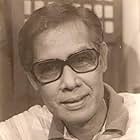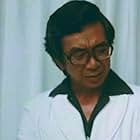THE MOVIE FOLLOWS THE EXPLOITS OF A MUSLIM SOLDER TASKED TO GET THE LEADER OF A CRIME SYNDICATE IN METRO MANILA.THE MOVIE FOLLOWS THE EXPLOITS OF A MUSLIM SOLDER TASKED TO GET THE LEADER OF A CRIME SYNDICATE IN METRO MANILA.THE MOVIE FOLLOWS THE EXPLOITS OF A MUSLIM SOLDER TASKED TO GET THE LEADER OF A CRIME SYNDICATE IN METRO MANILA.
- Awards
- 2 wins & 3 nominations
Photos
- Director
- Writers
- All cast & crew
- Production, box office & more at IMDbPro
Storyline
Did you know
- TriviaThe movie follows the exploits of a Muslim soldier tasked to get the leader of a crime syndicate in Metro Manila.
- ConnectionsReferenced in Alay ni da king: An FPJ special (2007)
Featured review
1986 saw the release of Da King, Fernando Poe Jr.'s classic masterwork, the memorable and legendary "Muslim .357". The film not only showcases FPJ's surprisingly nuanced portrayal of an undercover agent turned vigilante but also his most accomplished work behind the camera.
FPJ's film has inspired several imitations such as Jose Balagtas' "Omar Abdullah, Pulis Probinsya" and a remake, Francis Posadas' "Magnum Muslim .357". Though unlike the aforementioned knockoffs, the original is an award worthy action flick and gave the iconic actor a very well deserved acting recognition. The movie's script is also thoughtfully written and commendable for its non-formulaic and unpredictable narrative.
The protagonist of the film represents the evolution of FPJ's various roles from the 70s and 80s, culminating in the character of Lt. Jamal Razul, a soldier from the jungles of Mindanao who ends up in the urban wastelands of mid 80s Manila. Razul is an Islamic warrior from these Islands' pre colonial past transplanted in the modern era in much the same way that Clint Eastwood's Harry Callahan is a lawman from the Old Wild West transported to early 70s San Francisco; at least that's how FPJ approaches the character from a conceptual standpoint.
Arguably, this is FPJ's most defined and "poetic" role. Some may point to Celso Ad Castillo's Asedillo as his most eloquent and dramatic portrayal because of his epic speech in the final act. But this is also basically a hard action film (not a historical epic like Castillo's movie) and has no pretensions to high art though it is beautifully shot and employs all the techniques in classical filmmaking (the scenes of daytime Manila are particularly vivid). Razul's little prayer in the cemetery is proof that FPJ is not a one note actor but a thoughtful thespian who could deliver an imposing and terrific performance. That particular sequence is simply heartbreaking for its unvarnished simplicity and stark emotion.
In addition, FPJ is supported by several formidable actors. Obviously, the most memorable of these is Eddie Garcia's role as a corrupt police captain. His character isn't the typical generic villain but a more layered interpretation of a devious man who happens to be on the side of the law. In his final climactic confrontation with Razul, you could actually feel the captain's malignant rage and hatred with every word he delivers. A more timid actor could not have pulled off such a feat but Garcia's wide acting range would make today's actors seem like amateurs.
To conclude, "Muslim .357" is a testament to the enduring legacy of the one and only action king. A recent decision to name a street in Manila after the guy is not only an idiotic scheme but also illogical. FPJ's legend cannot be limited to a geographical location. He doesn't need a monument or have his name imposed on an alleyway or road. His movies are enough proof of his lasting contribution to Philippine culture.
FPJ's film has inspired several imitations such as Jose Balagtas' "Omar Abdullah, Pulis Probinsya" and a remake, Francis Posadas' "Magnum Muslim .357". Though unlike the aforementioned knockoffs, the original is an award worthy action flick and gave the iconic actor a very well deserved acting recognition. The movie's script is also thoughtfully written and commendable for its non-formulaic and unpredictable narrative.
The protagonist of the film represents the evolution of FPJ's various roles from the 70s and 80s, culminating in the character of Lt. Jamal Razul, a soldier from the jungles of Mindanao who ends up in the urban wastelands of mid 80s Manila. Razul is an Islamic warrior from these Islands' pre colonial past transplanted in the modern era in much the same way that Clint Eastwood's Harry Callahan is a lawman from the Old Wild West transported to early 70s San Francisco; at least that's how FPJ approaches the character from a conceptual standpoint.
Arguably, this is FPJ's most defined and "poetic" role. Some may point to Celso Ad Castillo's Asedillo as his most eloquent and dramatic portrayal because of his epic speech in the final act. But this is also basically a hard action film (not a historical epic like Castillo's movie) and has no pretensions to high art though it is beautifully shot and employs all the techniques in classical filmmaking (the scenes of daytime Manila are particularly vivid). Razul's little prayer in the cemetery is proof that FPJ is not a one note actor but a thoughtful thespian who could deliver an imposing and terrific performance. That particular sequence is simply heartbreaking for its unvarnished simplicity and stark emotion.
In addition, FPJ is supported by several formidable actors. Obviously, the most memorable of these is Eddie Garcia's role as a corrupt police captain. His character isn't the typical generic villain but a more layered interpretation of a devious man who happens to be on the side of the law. In his final climactic confrontation with Razul, you could actually feel the captain's malignant rage and hatred with every word he delivers. A more timid actor could not have pulled off such a feat but Garcia's wide acting range would make today's actors seem like amateurs.
To conclude, "Muslim .357" is a testament to the enduring legacy of the one and only action king. A recent decision to name a street in Manila after the guy is not only an idiotic scheme but also illogical. FPJ's legend cannot be limited to a geographical location. He doesn't need a monument or have his name imposed on an alleyway or road. His movies are enough proof of his lasting contribution to Philippine culture.
- Nen_Master357
- Feb 1, 2022
- Permalink
Details
Contribute to this page
Suggest an edit or add missing content












